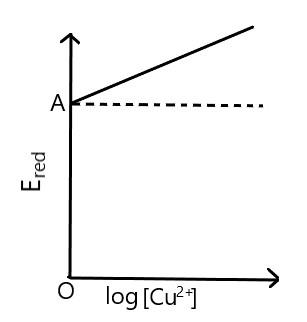

(A)
(B)
(C)
(D) none of these

Answer
468k+ views
1 likes
Hint :The electrode potential of a cell can be calculated by the use of Nernst equation, which establishes a relationship between the concentration of the ions in the cell as well as the electrode and standard electrode potential of the cell.
However, it also takes in account the number of electrons which are involved in the cell reaction so as to get a more precise value.
Cell potential which is also called the emf of the cell is represented by the symbol
Standard cell potential is denoted by
Complete Step By Step Answer:
In order to answer this question we will consider an equation known as the Nernst equation. The Nernst equation is a type of equation which establishes a relationship between the reduction potential of an electrochemical reaction with the standard electrode potential of the substance involved in the reaction, along with the activities and its temperature, of the chemical species which are observed to be undergoing reduction and oxidation. However, we will be using a modified version of the Nernst equation which will consider the concentration of the copper ions along with the electrode potential of the same.
Cell potential which is also called the emf of the cell is represented by the symbol
Standard cell potential is denoted by
Now, we will write this equation specifically for the copper reaction, which is,
The value of
Now, from the graph we can see that if
Also the value of electrode potential is provided to us as
So, now we will substitute this value in the equation of the Nernst equation, we get,
The value of ‘Q’ is provided to us in the question as
Which seems to be our answer. Now, if we consider the options which are provided to us in the question, we can see that option A is our correct option.
So, the correct option would be A.
Note :
The standard electrode potential is the potential of a half reaction which is measured on the basis of the electrode potential of the standard hydrogen electrode.
Standard conditions in which this measurement should be taken are temperature
However, it also takes in account the number of electrons which are involved in the cell reaction so as to get a more precise value.
Cell potential which is also called the emf of the cell is represented by the symbol
Standard cell potential is denoted by
Complete Step By Step Answer:
In order to answer this question we will consider an equation known as the Nernst equation. The Nernst equation is a type of equation which establishes a relationship between the reduction potential of an electrochemical reaction with the standard electrode potential of the substance involved in the reaction, along with the activities and its temperature, of the chemical species which are observed to be undergoing reduction and oxidation. However, we will be using a modified version of the Nernst equation which will consider the concentration of the copper ions along with the electrode potential of the same.
Cell potential which is also called the emf of the cell is represented by the symbol
Standard cell potential is denoted by
Now, we will write this equation specifically for the copper reaction, which is,
The value of
Now, from the graph we can see that if
Also the value of electrode potential is provided to us as
So, now we will substitute this value in the equation of the Nernst equation, we get,
The value of ‘Q’ is provided to us in the question as
Which seems to be our answer. Now, if we consider the options which are provided to us in the question, we can see that option A is our correct option.
So, the correct option would be A.
Note :
The standard electrode potential is the potential of a half reaction which is measured on the basis of the electrode potential of the standard hydrogen electrode.
Standard conditions in which this measurement should be taken are temperature
Recently Updated Pages
Master Class 12 Economics: Engaging Questions & Answers for Success

Master Class 12 Maths: Engaging Questions & Answers for Success

Master Class 12 Biology: Engaging Questions & Answers for Success

Master Class 12 Physics: Engaging Questions & Answers for Success

Master Class 12 Business Studies: Engaging Questions & Answers for Success

Master Class 12 English: Engaging Questions & Answers for Success

Trending doubts
Which are the Top 10 Largest Countries of the World?

a Tabulate the differences in the characteristics of class 12 chemistry CBSE

Why is the cell called the structural and functional class 12 biology CBSE

Differentiate between homogeneous and heterogeneous class 12 chemistry CBSE

Derive an expression for electric potential at point class 12 physics CBSE

What are the major means of transport Explain each class 12 social science CBSE




